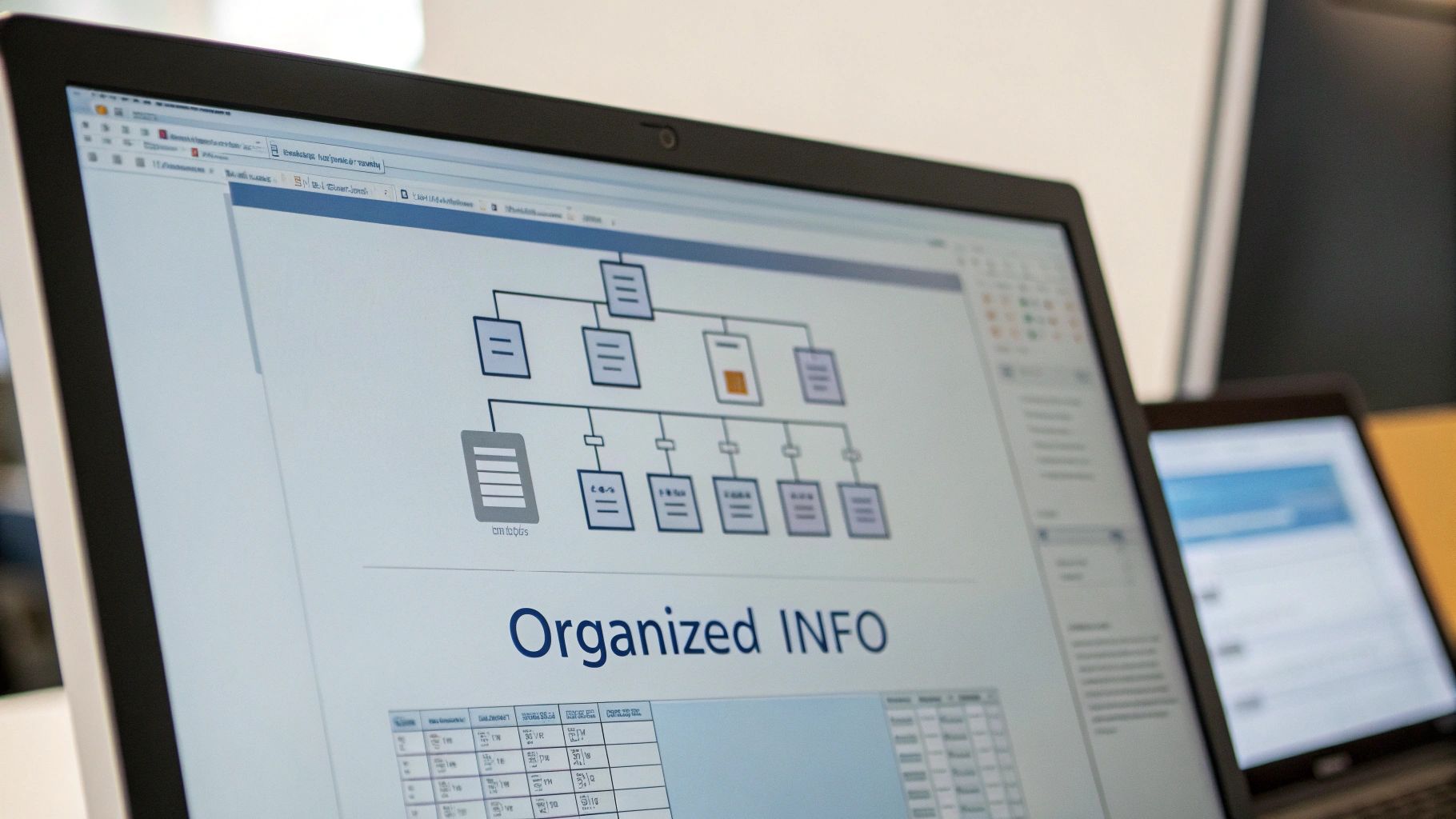Elevate Your Technical Writing Game
Strong technical writing skills are crucial for success in any tech-driven field. This listicle outlines eight essential skills to improve your documentation, user guides, and other technical materials. Master these skills to communicate complex information clearly, improve user comprehension, and increase the effectiveness of your projects. From clear writing to usability testing, these skills will empower you to create impactful technical content that elevates your work and helps your audience succeed.
1. Clear and Concise Writing
Clear and concise writing is the bedrock of effective technical communication. It’s the ability to convey complex technical information simply and directly, without unnecessary jargon, verbosity, or ambiguity. This involves distilling intricate concepts into digestible content that diverse audiences can easily understand and act upon. For technical writers, this translates to eliminating fluff and focusing on delivering information with precision and impact. For software developers, engineers, and startup founders, this skill is crucial for writing effective documentation, user guides, proposals, and internal communication.
This core principle hinges on several key features: economy of language (using the fewest words possible to convey meaning), precision in word choice and terminology (selecting the right words for the intended audience), logical organization of information (structuring content in a way that facilitates understanding), and the elimination of ambiguity (ensuring that there’s only one possible interpretation).

The benefits of adopting a clear and concise writing style are numerous. Improved readability and comprehension lead to greater user satisfaction and reduced frustration. For companies operating globally, concise writing decreases translation costs for international documentation. Internally, it streamlines communication among team members, minimizing misunderstandings and boosting productivity. Externally, concise documentation decreases support calls and user confusion, freeing up valuable resources. Ultimately, clear writing makes content more accessible to a wider range of audiences, including non-technical stakeholders.
Examples of successful implementation abound. Apple’s product documentation, renowned for its clarity and simplicity, serves as a prime example. Similarly, Google’s developer documentation effectively breaks down complex APIs into manageable chunks, making them easier for developers to grasp. The evolution of the Microsoft Style Guide, moving away from verbose language towards user-friendly guides, demonstrates the power of this approach in a large organization.
However, achieving clarity and conciseness is not without its challenges. Maintaining simplicity when explaining highly complex topics can be difficult and often requires a delicate balance between clarity and technical accuracy. Multiple revisions are often necessary to achieve optimal clarity, demanding patience and attention to detail. Learn more about Clear and Concise Writing
To incorporate clear and concise writing into your own work, consider these actionable tips:
- Use active voice: Active voice sentences are generally more direct and easier to understand than passive voice. For example, “The user clicks the button” is clearer than “The button is clicked by the user.”
- One idea per paragraph: Focus each paragraph on a single main idea to improve clarity and flow.
- Cut unnecessary words: Eliminate adverbs and adjectives that don’t add substantial value. “Very large” can often be replaced with “huge,” and “absolutely essential” can be simplified to “essential.”
- Read your work aloud: This helps you identify awkward phrasing and areas where the flow can be improved.
- Get feedback: Ask both technical and non-technical readers to review your work for clarity and comprehension. The importance of clear and concise writing has been championed by influential figures like William Strunk Jr. and E.B. White (authors of The Elements of Style) and William Zinsser (author of On Writing Well). Furthermore, the Plain Language Movement in government documentation highlights the widespread recognition of this principle’s value. By embracing these principles, technical professionals can significantly enhance the effectiveness of their communication, ultimately leading to improved products, stronger teams, and greater success.
2. Technical Subject Matter Expertise
Technical Subject Matter Expertise (TSME) is foundational for effective technical writing. It refers to possessing a solid understanding of the technical subject matter being documented, going beyond surface-level knowledge. Technical writers must comprehend the underlying principles of the systems, products, or processes they describe to effectively explain them to their target audience. This expertise empowers writers to ask insightful questions, anticipate user needs, and create accurate, comprehensive, and user-friendly documentation. Without a reasonable grasp of the technical domain, a writer risks misrepresenting information, overlooking crucial details, or creating documentation that is confusing and ultimately unhelpful.
This deep understanding enables writers to translate complex technical concepts into accessible explanations. They can break down intricate processes into digestible steps, clarify jargon, and provide meaningful examples that resonate with their intended audience. This ability to bridge the gap between technical complexity and user understanding is a defining characteristic of a skilled technical writer with strong TSME.

Features of Strong Technical Subject Matter Expertise:
Deep understanding of the technical domain: This includes the principles, terminology, and functionalities relevant to the subject matter.
Ability to translate technical concepts into accessible explanations: Transforming complex ideas into clear, concise, and user-friendly language.
Skill in identifying what information users need most: Anticipating user questions and pain points to provide targeted and relevant information.
Capacity to validate technical accuracy independently: Verifying information without relying solely on subject matter experts (SMEs). Pros:
Enables more accurate and comprehensive documentation, minimizing errors and omissions.
Reduces dependency on SMEs, freeing up their time for core tasks and streamlining the documentation process.
Allows writers to anticipate user questions and pain points, leading to more effective and user-centered documentation.
Facilitates better collaboration with engineering teams, fostering a shared understanding of the product and its functionalities. Cons:
Requires continuous learning as technology evolves. Writers must stay updated with the latest advancements in their domain.
Can lead to documentation that’s too technical if not balanced with audience awareness. Writers must tailor their language and level of detail to the target audience’s technical proficiency.
May create challenges when switching between different technical domains. Adapting to new technologies and terminologies can require significant effort. Examples of Successful Implementation:
API documentation writers who understand programming concepts and can provide meaningful code examples.
Software documentation specialists who can test features themselves before documenting them, gaining firsthand experience with the product’s functionality.
Technical writers at companies like IBM who become certified in the technologies they document, demonstrating a commitment to deep technical understanding. Tips for Developing TSME:
Dedicate regular time to learning the technologies you document: Set aside specific time for self-study and exploration.
Take relevant courses or certifications in your technical domain: Formal training can provide a structured learning path and validate your expertise.
Practice using the products or systems you document: Hands-on experience is crucial for understanding functionalities and potential user challenges.
Build relationships with developers and engineers for knowledge sharing: Direct communication with SMEs provides valuable insights and clarifies technical details.
Maintain a personal knowledge base of technical concepts: Documenting key concepts, terminology, and processes helps solidify understanding and provides a readily accessible reference. TSME earns its place in this list because it is the bedrock of effective technical communication. It empowers writers to create documentation that is not only accurate and comprehensive but also user-centered and truly helpful. While maintaining this expertise requires ongoing effort, the benefits—in terms of documentation quality, user satisfaction, and streamlined workflows—are substantial. The emphasis on technical knowledge in programs like Microsoft’s certification program for technical writers and Google’s Technical Writing courses further underscores the importance of TSME in the field. For software developers, engineers, tech startups, and other technical professionals, understanding the importance of TSME in their documentation processes is crucial for creating successful products and fostering user adoption.
3. Audience Analysis
Audience analysis is a crucial skill for technical writers. It involves identifying, understanding, and adapting content to the specific needs, knowledge level, and expectations of the intended audience. This means going beyond simply conveying information and focusing on crafting documentation that truly resonates with users by addressing their specific contexts, technical backgrounds, and goals within the software or product ecosystem. Effectively implemented audience analysis directly impacts the usability and efficacy of technical documentation.
For software developers, engineers, and technical writers alike, understanding the audience is paramount. Are you writing for seasoned developers who need concise API references? Or are you targeting end-users who require step-by-step instructions for navigating a software application? Perhaps you’re addressing both, requiring layered documentation that caters to varying expertise.

This skill encompasses several key features: developing user personas, employing needs assessment methodologies, adapting content complexity, exhibiting cultural and linguistic awareness, and cultivating empathy for user challenges. For instance, user persona development involves creating fictional representations of ideal users, allowing writers to envision their target audience’s needs and behaviors. Needs assessment involves actively gathering information about the audience’s specific requirements related to the documentation. Adapting content complexity ensures that the language, technical depth, and format of the documentation align with the audience’s expertise.
The benefits of effective audience analysis are manifold. It leads to more relevant and useful documentation, improving user satisfaction and product adoption. By anticipating user questions, it reduces support costs and allows for more strategic content planning. Stripe’s API documentation is an excellent example of serving both beginners and advanced developers through layered content. Similarly, Canva’s help documentation effectively addresses both casual users and design professionals, demonstrating the practical application of audience analysis. Another example is medical device documentation which needs to be clear and accessible for both healthcare providers and technicians.
However, audience analysis also presents challenges. Writing for multiple audience segments simultaneously can be complex, potentially necessitating the creation of multiple versions of documentation. Furthermore, ongoing research is required as user demographics and needs evolve.
Tips for effective audience analysis:
- Create detailed user personas: Before starting any documentation project, define your target audience(s) by creating detailed user personas. Include demographics, technical skills, goals, and potential pain points.
- Conduct user interviews and surveys: Actively gather feedback from representative users to understand their specific needs and expectations.
- Test documentation with representative users: Usability testing with target users before publication is crucial for identifying areas for improvement and ensuring clarity.
- Use progressive disclosure: Structure documentation to cater to different levels of expertise by providing layered information. Start with basic concepts and progressively reveal more advanced details.
- Consider cultural contexts: For global documentation, be mindful of cultural nuances and language differences. Audience analysis earns its place in this list because it forms the foundation for effective technical communication. By understanding your audience, you can create documentation that is not just technically accurate but also user-centered and impactful, ultimately contributing to a positive user experience and successful product adoption. The principles of audience analysis are popularized by influential figures in user-centered design and technical communication such as Janice (Ginny) Redish, Don Norman, and Karen Schriver, solidifying its importance in the field.
4. Information Architecture and Organization
Effective technical documentation hinges on users being able to find the information they need quickly and easily. This is where information architecture and organization come into play. This critical skill involves structuring and organizing complex technical information in a logical, intuitive manner, making it readily accessible and usable for your target audience. It encompasses creating coherent structures, taxonomies, and navigation systems that transform potentially overwhelming amounts of content into a user-friendly resource. This is essential for any technical writer aiming to create truly effective and impactful documentation.
Information architecture considers the relationships between different pieces of information and uses these relationships to design a structure that supports user needs. This structure might be hierarchical, topic-based, or task-oriented, depending on the nature of the content and the user’s goals. A robust information architecture allows users to intuitively navigate the documentation, understand the context of the information presented, and quickly locate the specific details they require.

Consider examples like Atlassian’s product documentation, known for its consistent structure and intuitive navigation, or AWS documentation, which manages to present a vast and complex subject matter in a navigable way. GitHub’s help documentation also demonstrates effective information architecture with its clear categorization and contextual linking. These successful implementations showcase the power of well-organized information. They highlight how a focus on architecture translates directly to a positive user experience.
Features of effective information architecture and organization include:
Hierarchical organization of information: Creating a logical hierarchy allows users to understand the relationship between different topics and drill down to the level of detail they need.
Creation of consistent information models: Using consistent templates and structures makes it easier for users to predict where information will be located and how it will be presented.
Development of effective navigation systems: Clear and intuitive navigation, including menus, search functionality, and cross-linking, is crucial for helping users find their way around the documentation.
Chunking of content into manageable units: Breaking down large blocks of text into smaller, digestible chunks makes the information easier to scan and absorb.
Implementation of content patterns and templates: Consistent patterns and templates make it easier to maintain and update the documentation over time. Pros:
Improves findability of information: Users can quickly locate the specific information they need.
Reduces cognitive load for users: A clear structure makes it easier for users to process and understand complex information.
Facilitates content reuse and maintenance: A well-organized system makes it easier to update and reuse content across different parts of the documentation.
Creates scalable documentation systems: As the documentation grows, a strong information architecture ensures it remains manageable and user-friendly. Cons:
Can be time-consuming to implement properly: Developing a robust information architecture requires careful planning and execution.
May require specialized tools and systems: Depending on the scale and complexity of the documentation, specialized tools may be needed for content management and organization.
Often requires balancing multiple stakeholder needs: Different stakeholders may have different priorities for the documentation, and the information architecture needs to accommodate these diverse requirements. Actionable Tips:
Conduct card sorting exercises: Involve potential users in card sorting exercises to validate your organizational structure and understand how they naturally categorize information.
Create a content inventory: Before reorganizing existing documentation, create a comprehensive inventory of all content to identify gaps and redundancies.
Use consistent naming conventions and terminology: This improves clarity and makes it easier for users to find what they’re looking for.
Implement breadcrumbs and contextual navigation: These features provide users with a sense of location and help them navigate within the documentation.
Test navigation paths with actual users: User testing is essential for identifying any usability issues and ensuring the navigation is intuitive and effective.
Design for both searching and browsing behaviors: Some users prefer to search for specific information, while others prefer to browse. The information architecture should support both approaches. Information architecture and organization are not just “nice-to-haves” but essential elements of successful technical writing. By prioritizing these aspects, you create documentation that is not only comprehensive but also readily accessible and genuinely useful for your target audience – whether they are software developers, engineers, startup founders, or freelancers. This, in turn, contributes to a positive user experience, improved product adoption, and ultimately, greater project success.
5. Visual Communication
Visual communication is a critical skill for technical writers, encompassing the ability to leverage diagrams, screenshots, illustrations, and other visual elements to enhance understanding of complex technical information. It involves not just creating visuals, but carefully selecting and integrating them with text to clarify information, rather than adding unnecessary complexity. This skill is crucial for creating effective and engaging documentation that caters to a wide audience.
How it Works: Visual communication operates on the principle that visual processing is often faster and more intuitive than textual processing. A well-chosen diagram can instantly convey the relationships between components of a system, while a screenshot can demonstrate a specific software function more effectively than paragraphs of descriptive text. This approach reduces cognitive load on the reader, making information more accessible and digestible.
Examples of Successful Implementation:
Cisco’s Networking Documentation: Cisco masterfully utilizes clear topology diagrams to visualize network architectures, making complex configurations easier to understand. These diagrams provide a clear overview of the network’s structure and the relationships between various devices.
Tableau’s Help Center: Tableau incorporates interactive visual examples, allowing users to explore data visualization concepts dynamically. This interactive approach enhances user engagement and facilitates deeper understanding.
Arduino Documentation: Arduino’s documentation excels with its clear circuit diagrams and component illustrations, making it straightforward for users to build and troubleshoot hardware projects. Tips for Effective Visual Communication:
Start Simple: Begin with low-fidelity sketches to brainstorm and plan visual layouts before creating finalized versions.
Consistency is Key: Maintain consistent visual styles and conventions throughout your documentation to create a cohesive and professional look and feel.
Accessibility Matters: Always include appropriate alt text for images to ensure accessibility for users with visual impairments.
Balance Complexity with Clarity: While visuals can enhance understanding, overly complex visuals can be confusing. Strive for a balance between detail and clarity of purpose.
Create a Visual Style Guide: Develop and adhere to a visual style guide for your documentation to ensure consistency across all visual elements.